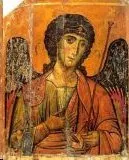Sep 29, 2016
According to Wikipedia, in the British Isles, Michaelmas is celebrated on September 29. As the Feast of St. Michael within the Catholic church, this date is often associated with the harvest because of its proximity to the autumn equinox. Although it's not a Pagan holiday in the true sense, Michaelmas celebrations often included older aspects of Pagan harvest customs, such as the weaving of corn dolls from the last sheaves of grain. The feast was celebrated as far back as the 6th Century CE.
During the medieval period, Michaelmas was considered one of the holy days of obligation, although that tradition ended in the 1700s. Customs included the preparation of a meal of goose which had been fed on the stubble of the fields following the harvest (called a stubble-goose). There was also a tradition of preparing special larger-than-usual loaves of bread, and St. Michael's bannocks, which was a special kind of oatcake.
“Eat a goose on Michaelmas Day,
Want not for money all the year”.
By Michaelmas, the harvest was typically complete, and the next year's farming cycle would begin as landowners saw reeves elected from among the peasants for the following year. The reeve's job was to watch over the work and make sure everyone was doing their share, as well as collecting rents and donations of products. If a holding's rent fell short, it was up to the reeve to make it up - as you can imagine, no one really wanted to be reeve. This was also the time of year when accounts were balanced up, annual dues paid to local guilds, and new leases taken for the following year.
The popular saying to eat goose on the Feast Day of St. Michael is only one of the many rich customs associated with Michaelmas. The customs and celebrations surrounding feast days are an essential part of the Christian tradition. Many times an entire meal is shared to its last detail in symbolic meaning. Customs and recipes for traditional dishes are handed down from generation to generation. For instance, celebrating St. Michael's Day in the Celtic tradition may include Michaelmas Pie. (the quaint custom of hiding a ring in the pie led to the expectation of marriage in the coming year.) St. Michael's Bannocks or Saint Michael’s Cake. In the traditional ceremonies in Scotland, all guests, together with their family, were required to eat the large, scone-like cake entirely before the night was over. Traditionally the Struan Michaels (Struan Micheil) was not allowed to touch metal while cooking.
Another ceremony practiced in Scotland during this time was Carrot Sunday. On the Sunday before the Feast Day of Saint Michael, Scottish women went into the fields to dig up wild carrots, Queen Anne's Lace. If they found carrots that were twisted or forked, they were delighted with the gift of the earth, which was thought to bring luck and fertility. In the fashion of a more modern day Sadie Hawkins Dance, a woman offered the coveted forked carrot bunch to her intended tied with a red ribbon.
In Cooking for Christ, Florence Berger (1949) states that waffles baked in a Gaufrette Iron, St. Michael's Guafres are traditional for Michaelmas Day in France. I found an American version of St. Michael's Waffles:
(http://www.catholicculture.org/culture/liturgicalyear/recipes/view.cfm?id=244)
In some parts of Europe, especially Germany, Denmark, and Austria, a special wine called "Saint Michael's Love" (Michelsminne) is drunk on this day. Germans also believed they could foretell the weather from the breastbones of the Michaelmas goose — a belief that traveled to America with German immigrants, and still exists today among the Pennsylvania Dutch. In Italy, gnocchi is the traditional fare and the aster amellus or Italian Starwort is the original plant dedicated to St. Michael the Archangel.
St. Michael is the patron saint of artists, hat-makers, grocers, knights, mariners, policemen, radiologists, the sick, and soldiers. St. Michael the Archangel is also the universally recognized patron saint of the paratroopers around the world. There are also superstitious folk lores associated with the feast day of St. Michael. According to an old legend, blackberries should not be picked after this date. It is believed that the devil was banished from Heaven and as he fell from sky he landed in a blackberry bush. He cursed the bramble and made it unfit for human consumption. Legend has it that each September 29th he renews his curse and therefore one must not pick blackberries after Michaelmas.
Image: Archangel St. Michael icon - Wikipedia
Share this article with friends!
Tags:
#michaelmas,#st.#michael,#feast,#customs,#archangel#st.#michael,#starzpsychics.com,#starz#advisors

